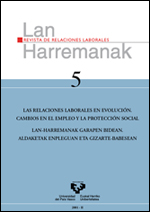Empleo atípico y mercado de trabajo
##plugins.themes.bootstrap3.article.main##
##plugins.themes.bootstrap3.article.sidebar##
Resumen
Durante las dos últimas décadas un porcentaje importante de países pertenecientes a la Unión Europea ha modificado la regulación de determinados elementos del mercado de trabajo. Una de las reformas más difundidas entre los mismos ha sido el desarrollo de la legislación tendente al fomento de los contratos de trabajo denominados «atípicos», es decir, los relativos a una duración temporal y a tiempo parcial. Como resultado de dichas regulaciones, se ha producido un importante incremento de la participación de estas tipologías contractuales en el total empleo, produciéndose una segmentación del mercado de trabajo. Este estudio persigue dos objetivos básicos. El primero es el establecimiento de las características fundamentales de los trabajadores atípicos en la Unión Europea, destacando las principales similitudes y diferencias con respecto a lo ocurrido en España. El segundo, determinar si el contrato de trabajo a tiempo parcial puede considerarse un instrumento eficaz en la creación de empleo.
Cómo citar
##plugins.themes.bootstrap3.article.details##
Los autores que publican en la revista "Lan Harremanak" lo hacen de acuerdo con los siguientes términos:
1. Los autores conservan los derechos de autor de sus trabajos, cediendo a la revista "Lan Harremanak" el derecho a la primera publicación de su artículo.
2. La editorial UPV/EHU Press es copropietaria de los derechos de autor, con el fin de proteger el uso legítimo del artículo publicado y el cumplimiento de los términos CC.
3. Los artículos publicados están sujetos a una licencia CC-BY de Creative Commons (a menos que se indique lo contrario) que permite a terceros compartir el artículo, con la condición de que se especifique el autor y la fuente cuando se reproduce el material.
4. Los autores pueden celebrar otros acuerdos de licencia no exclusivos con respecto a la versión publicada de su trabajo (por ejemplo, depositarlo en un repositorio institucional o volver a publicarlo como un volumen monográfico), siempre que el autor y la fuente reciban el crédito apropiado.
5. La difusión de los artículos enviados a través de Internet está permitida y recomendada (por ejemplo, en repositorios institucionales y/o en la página web del investigador), tanto antes como durante el proceso de envío, ya que esto puede generar diálogos interesantes y también aumentar las citas a la eventual publicación.

